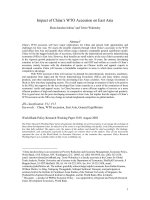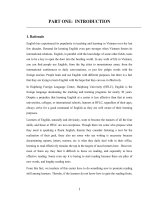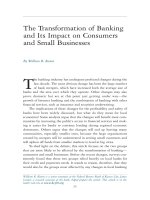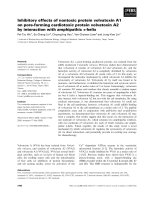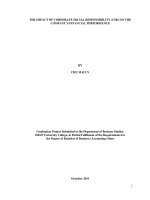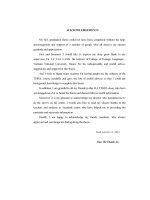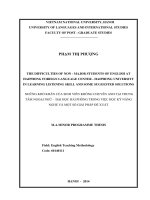Investigating theeffects of teaching communicative writing skills on intermediate EFL learners writing performance at saigon vina language center a thesis submitted in partial fulfillment
Bạn đang xem bản rút gọn của tài liệu. Xem và tải ngay bản đầy đủ của tài liệu tại đây (1.45 MB, 138 trang )
MINISTRY OF EDUCATION AND TRAINING
HO CHI MINH CITY OPEN UNIVERSITY
INVESTIGATING THE EFFECTS OF
TEACHING COMMUNICATIVE WRITING
SKILLS ON INTERMEDIATE EFL
LEARNERS’ WRITING PERFORMANCE AT
SAIGON VINA LANGUAGE CENTER
A thesis submitted in partial fulfillment
of the requirements for the degree of
Master of Arts (TESOL)
Submitted by NGUYEN
THI THAO PHUONG
Supervisor
NGUYEN DINH THU Ph.D
Ho Chi Minh City, October 2016
STATEMENT OF AUTHORITY
I hereby certify that this thesis is based on my original work except for
quotations and citations which have been duly acknowledged. I also declare
that it has not been previously or currently submitted for any degree at this
university or others.
Name: Nguyen Thi Thao Phuong
Signature:
Date:
i
ACKNOWLEDGEMENTS
First, I would like to express my deep and sincere thanks and gratitude
to my supervisor, Nguyen Dinh Thu Ph.D, for his continuous professional
support and encouragement. Without his guidance, follow-up, and endless
patience, this thesis would not have been completed.
Thanks also go to my colleagues who are always ready to support
me,give me advice and insightful comments during my thesis writing.
Gratitude is owed to all my students, who participated in the study
groups for their patience and cooperation. They have been working with me
during the time I conducted the study, which is highly appreciated.
I also wish to express my deep love and appreciation to my parents,
brothers and sisters for their encouragement, inspiration and support me
throughout my life. I am very much thankful to them for their unswerving
love, understanding and continual support to the end of the thesis writing.
Finally, I would like to acknowledge the Manager and the staff of
Saigon Vina language center, who have given me best conditions, support
and assistance during my study.
ii
ABSTRACT
This study is carried out in order to identify the effects of teaching
communicative writing on students’ writing performance and investigate
what students’ attitudes towards teaching communicative writing skills are.
The study involved 68 intermediate students from 6 classes at Saigon
Vina language center. In the study, the pre-test and post-test were used to
explore how teaching writing skill in a communicative way affects students’
writing performance. In addition, a set of questionnaire was distributed to
students, then was collected and analyzed so as to find out whether or not
students like the implementation of the communicative approach into
teaching writing.
The results of the study showed that implementing communicative
approach to teach writing has positive effects on students’ writing
performance. The writing scores of experimental group indicated that there
was a significant improvement in writing ability after the treatment. The
findings from the questionnaire also give an optimistic perspective of
implementing of teaching writing communicatively as most of the
respondents
expressed
their
supportive
communicative writing.
iii
attitude
towards
teaching
TABLE OF CONTENTS
Page
Statement of authority ............................................................................................. i
Acknowledgements ................................................................................................ ii
Abstract ................................................................................................................. iii
Table of contents ................................................................................................... iv
List of tables ........................................................................................................ viii
List of abbreviations ...............................................................................................x
CHAPTER 1. INTRODUCTION ........................................................................1
1.1. Background of the study ..................................................................................1
1.2. Statement of problems .....................................................................................3
1.3. Teaching material .............................................................................................4
1.4. Purposes of the study .......................................................................................4
1.5. Research Questions ..........................................................................................5
1.6. Significance of the study ..................................................................................5
1.7. Organization of the study .................................................................................5
CHAPTER 2. LITERATURE REVIEW ............................................................7
2.1. Introduction ....................................................................................................7
2.2. The notion of writing .......................................................................................7
2.2.1. Definition of writing ...............................................................................7
2.2.2. Writing approaches...............................................................................10
2.2.2.1. Product-based approach ............................................................10
2.2.2.2. Process-based approach ............................................................13
2.2.2.3. Genre-based approach ..............................................................16
iv
2.3. Comparing the product-based, process-based, and genre-based
approaches ...................................................................................................18
2.4. The approach in the study: Communicative writing ......................................20
2.4.1. Definition of communicative writing ...................................................20
2.4.2. What is not communicative in the writing classes ...............................21
2.4.3. The effectiveness of teaching communicative writing ........................23
2.5. The implication of teaching communicative writing .....................................25
2.6. Empirical studies ............................................................................................26
2.7. Chapter summary ...........................................................................................28
CHAPTER 3. RESEARCH METHODOLOGY..............................................29
3.1. Introduction ....................................................................................................29
3.2. Research design .............................................................................................29
3.2.1. Research site .........................................................................................29
3.2.2. Participants ...........................................................................................30
3.3. Research methods ..........................................................................................30
3.4. Research questions .........................................................................................31
3.5. Data collection ...............................................................................................32
3.5.1. Research instruments ............................................................................32
3.5.1.1. Writing test: Pre-test and post-test............................................33
3.5.1.2. Questionnaire ............................................................................33
3.5.1.3. Experimental teaching procedures............................................36
3.5.2. Data collection procedure .....................................................................40
3.6. Data analysis approaches ...............................................................................40
3.6.1. Analysis from the questionnaire ...........................................................40
v
3.6.2. Analysis from the pre-test and post-test ...............................................41
3.7. Validity and reliability of instruments ...........................................................42
3.8. Chapter summary ...........................................................................................43
CHAPTER 4. DATA ANALYSIS, FINDINGS AND DISCUSSION............44
4.1. Introduction ...................................................................................................44
4.2. Research question 1: Does teaching writing in communicative way affect
students’ writing performance? ...................................................................44
4.2.1. Before the treatment .............................................................................44
4.2.2. After the treatment................................................................................46
4.2.3. Summary ..............................................................................................51
4.3. Research question 2: What are the students’ attitudes towards teaching
communicative writing? ...............................................................................52
4.4. Discussion of results ......................................................................................61
4.4.1. Students’ writing performance .............................................................62
4.4.2. Students’ attitudes towards teaching communicative writing ..............65
4.5. Chapter summary ...........................................................................................68
CHAPTER 5. CONCLUSIONS AND RECOMMENDATIONS ...................69
5.1. Introduction ....................................................................................................69
5.2. Main conclusions ...........................................................................................71
5.3. Limitations of the study .................................................................................71
5.4. Recommendations ..........................................................................................71
5.5. Suggestions for further studies.......................................................................72
5.6. Chapter summary ...........................................................................................72
vi
REFERENCES......................................................................................................73
APPENDICES ......................................................................................................80
vii
LIST OF TABLES
Table 4.1. Group Statistics on pre-test of control group and experimental group
Table 4.2. Independent samples t-test of the two groups before the experiment
Table 4.3. Group statistic of post-test results
Table 4.4. Independent Samples T-test of two groups after treatment
Table 4.5. Paired Samples T-test of the control group before and after the
teaching instruction
Table 4.6. Paired Samples Correlations of the control group before and after
the teaching instruction
Table 4.7. Paired Samples Test of the control group before and after the
teaching instruction
Table 4.8. Paired Samples T-test of the experimental group before and after
the treatment
Table 4.9. Paired Samples Correlations of the experimental group before and
after the treatment
Table 4.10. Paired Samples Test of the experimental group before and after
the treatment
Table 4.11. Reliability Statistics
Table 4.12. Students’ responses towards types of writing texts used
Table 4.13. Students’ responses towards communicative aspects of the writing
Table 4.14. Students’ response towards the skills integrating with writing
Table 4.15. Students’ response towards topics used in the treatment
Table 4.16. Students’ comments about tasks and instructions teacher given
Table 4.17. Students’ responses towards the activities employed
viii
Table 4.18. Students’ level of confidence on composing writing texts after
the treatment.
Table 4.19. Students’ engagement and learning motivation after the treatment
Table 4.20. Students’ response towards the effectiveness of the communicative
approach in teaching writing.
Table 4.21. The effectiveness of implementing pair work and group work in
teaching communicative writing.
Table 4.22. Students’ responses to the effectiveness of teaching experiment.
ix
LIST OF ABREVIATIONS
SPSS
: Statistical Package for the Social Sciences
EFL
: English as Foreign Language
ESL
: English as Second Language
S.D
: Standard Deviation
Sig. value
: Significance value
x
CHAPTER 1
INTRODUCTION
1.1. Background of the study
Of the four basic skills, writing is considered to be extremely difficult
for students in language learning. According to Semistraitis (2003),
structuralists and audiolinguists emphasised oral forms of communication
and reading, but left writing at the last stage of learning. The teaching of
writing skills has not been paid much attention from teachers and investment
from students. A lot of students do not like writing because it takes a lot of
time and requires them to pay much attention to. In reality, in many high
schools or colleges, writing classes are still language-based writing classes
for exam-orientation, but not for compositions of real-life context. As above
mentioned, teachers seem not to pay due attention to teaching writing or
integrating students to write communicatively, which makes students more
and more difficult to write effectively. Normally, when writing, students just
attempt to concentrate on the grammar points and structures they are dealing
with. They have no purpose for what they are writing, but for being forced to
write. In other words, they will be difficult to perform on an English
composition when being asked to write since under the psychological
pressure, students easily find difficult in expressing their linguistic ability,
their capacity of generating the ideas or organizing, putting ideas intelligibly.
Once there is no purpose and meaning for what they do, students’ motivation
in learning writing will decrease. In this case, teachers just promote students
with some writing skills to help them pass the exam rather than to help them
improve writing with a specific purpose and meaning.
As we know, in high school context, writing was utilized as supporting
skills in order to help students achieving other language skills. For instance,
students could use writing skills to do grammar exercises, to give the answer
1
for reading comprehension tests or to write the dictation. And vice versa,
students learn writing skills by doing many grammar-based drills rather than
a compositional text. It can be said that compositional writing was not what
students work with when teachers conduct their writing lessons. However,
compositional writing skill is now regarded as important as any other skills
and is taught in EFL classrooms as a separate skill accompanied by reading,
listening, and speaking skills. When writing a composition, besides having
knowledge of vocabularies and grammar structures, students are dealing with
writing on a topic, following that theme and aiming at improving other subskills such as reasoning skills, creative skills or problem-solving skills. The
compositions should be of real-life contexts, which help students to identify
and understand who their real audience of what they are writing is.
Nowadays, together with changes in English teaching methodology
paradigms and the demands in written communication, writing has now been
taught as an important skill to help students communicate effectively. For
language learning, students need to pay much attention to improve
communicative ability and use language effectively. Particularly, learning
writing skills requires students to take into account the communicative
purpose and the communicative technique. It’s important to apply into
writing lessons with communicative aspects so as to enhance students’ use of
the language to write in a communicative way. Therefore, facilitating
students to write with a purpose and meaning is necessary to develop their
writing performance.
According to Lam (2013), the four language skills are of an equal
importance in teaching language, teaching writing still encounters obstacles:
adopted methods in teaching are mostly product-based, and another is from the
current assessment system focusing on reading and grammar rather than
writing. Currently, in almost all language centers, the concentration is on
developing oral communication skills for students or meeting the need of
2
certificate for the personal purposes, which also makes the obstacles for
learning language effectively. The length of courses has not been enough to
train students every English skill. Teachers have tendency to focus on
improving students’ speaking or listening skills and help them get through the
international certificate with practicing given tests. There exists a shortage of
attention to teaching and learning writing communicatively with a purpose and
meaning. Therefore, teachers should facilitate students with sufficient
linguistic input and the attention in order to encourage them to write.
Moreover, the characteristics of writing required in different text types need to
be considered so that students can convey their ideas on the topic and meet the
expectation of the readers. In general, the research attempts to seek ways in
order to help students enhance their writing skill and applying communicative
approach in teaching writing is considered as an effective tool.
1.2. Statement of Problems
Saigon Vina was established in 2010 to provide the English training for
students of various ages. Each class studies with one Vietnamese teacher
who is in charge of teaching the four skills of English and with one foreign
teacher focusing on speaking with two periods every two weeks. Vietnamese
teachers are required to teach all the units in the course book, the Smart
Choice 2 (the second edition) by Ken Wilson, Oxford University Press
(2007). In order to promote students’ pronunciation as well as speaking skills,
foreign teachers are assigned to teach them pronunciation aspects together
with the discussion of other real-life topics outside the textbook.
Understanding the importance of teaching language skills, Saigon Vina
Language Center has tried to facilitate students here with language
knowledge in a most effective way to help them be confident to
communicate with others in English. Students can be active in learning
English, and from that, they can communicate effectively. They have had
access to the communicative activities in each lesson. However, like almost
3
all schools or language centers, Saigon Vina Language Center also faces
difficulty in teaching writing skills for students. In reality, writing is known
as the most difficult skill of the four basic language skills. Therefore, the big
concern of teachers here is how to improve students’ writing skill. Students
just know the grammar rules and structures, but cannot be able to put the
language into their writing. Sometimes students depend on what teachers
give them to write. In some cases, they have their writing based on the
available models of writing, lacking of creativity in ideas and ways of
organizing their writing. As a result, an urgent need to change the way of
teaching writing is essential. Together with the application of communicative
approach into teaching reading, speaking and listening language skills,
teaching writing communicatively will be effective for students’ writing
performance.
1.3. Teaching material
The main course book to teach English for intermediate classes is Smart
Choice 2 (the second edition) by Ken Wilson, Oxford University Press
(2007). The whole course book makes up of 12 units, in which the four skills
of listening, speaking, reading, and writing are integrated. The primary goal
of the course book is to teach students the communicative competence - the
ability they use to communicate in English in proportion of the situations,
purposes, and roles they act in specific real contexts. Throughout the course,
students have the opportunities to personalize the language they learn, to
make use of their own world knowledge, and to express their opinions and
ideas. Though the focus of the course book is speaking skills, many other
elements like grammar, functions, topics, vocabulary, listening, etc, are
provided to enable students to support for their written communication.
1.4. Purposes of the study
This research is conducted to investigate two objectives as follows:
4
(1) To identify the effects of teaching communicative writing on students’
writing performance.
(2) To investigate students’ attitudes towards teaching communicative
writing skills.
1.5. Research Questions
To achieve the stated objectives above, the research is aimed at seeking
the answer to the main research question:
To what extent can communicative approach be implemented in teaching
writing skill to intermediate students at Saigon Vina Language Center?
Based on the main research question, there are two sub-questions:
1. Does teaching writing in communicative ways affect students’writing
performance?
2. What are the students’ attitudes towards teaching communicative
writing?
1.6. Significance of the study
This research is carried out with the hope to gain some insights into
teaching writing in communicative way
It is hoped that the findings of the research will offer some useful
suggestions for applying communicative approach into teaching students’
writing skills so that they can use the language to write communicatively and
effectively.
1.7. Organization of the study
This research consists of five chapters. Chapter 1, the introduction,
provides background information of the study, statement of the problems and
the statement of the purposes. This chapter also presents research questions,
significance of the study and the overview of study. Chapter 2 consists of the
theoretical background information of the study and a review of related
5
literature for the research. Chapter 3 describes the research methodology
employed for the research, which presents the research methods, research
site, sampling, research instruments, data collection and data analysis. This
chapter also goes through the validity and reliability of the study. As for
chapter 4, it includes the analyses of the data collected from the instruments,
namely pre-test and post-test, and the questionnaire; then is followed with
finding discussion. Chapter 5 gives out some main conclusions of the
research, points out some limitations, and offers some recommendations, and
suggestions for further research.
6
CHAPTER 2
LITERATURE REVIEW
2.1. Introduction
As one of the most challenging aspects of language learning in foreign
language classrooms, writing requires students to have extensive effort and
the teacher the specialized instruction. Not only do ESL/EFL student writers
have to learn the linguistic features of the English language but also its
rhetorical aspects and conventions. These features are usually different from
those of their first language, so it is essential for students to make effort with
writing in order to communicate effectively with presumed readers. While
linguistic features such as grammar, vocabulary, and spelling are nearly
always stressed in ESL/EFL classrooms, communicative aspects are focused
on less, or are sometimes ignored. Once communicative approach is adopted
for language teaching and learning, the context of language use is treated as
an important factor in defining, teaching and measuring language ability,
especially in writing.
2.2. The notion of writing
To most of the languages, writing plays an important role in
representing the language and emotion. It is considered as a medium of
human communication in which language and emotion are mainly expressed
through the inscription or recording of signs and symbols. It is a complement
to speech or spoken language, which makes the totality of the language.
2.2.1. Definition of writing
Many educators have contributed to the sources of theory of teaching
language many definitions and solutions for teaching issues related to four
basic language skills including writing. And the following are some of
definitions of writing on the ground of the main writing approaches.
7
Writing, firstly, is considered as a textual product (Nguyen-Dieu,
2013). As Byrne (1988) stated, writing is the act in which people form the
graphic symbols and put them together so as to make meaningful words and
sentences. Like Byrne, Tribble (1996) showed his agreement of the idea that
writing is spoken in graphic forms and helps to express human thoughts.
Similarly, Ager (1998) stated that writing is the method in which language is
represented in the visual or tactile form. It is made up of a set of symbols that
is utilized to represent the sound of speech, and also another for other
different functions such as punctuation and numerals. All these symbols help
express the writer’s ideas directly. In general, writing is a form of
communication that allows students to put their feelings and ideas on paper,
to organize their knowledge and beliefs into convincing arguments, and to
convey meaning through well-constructed texts.
Secondly, regarding to the process approach, writing is a cognitive
process (Flower & Hayes, 1981; Zamel, 1983). Accordingly, the writers paid
attention to their ideas, thinking and experiences during the writing process
so that they can make a better text. As children learn the steps of writing, and
build new skills, writing evolves from the first simple sentences to elaborate
stories and essays. Spelling, vocabulary, grammar, and organization come
together and grow together to help students demonstrate more advanced
writing skills each year.
Nguyen-Dieu (2013) mentioned that writing plays an important role in
expressing the communicative functions of language. It can be said to be the
bridge which helps writers turn their thoughts into written forms in a
meaningful way to serve the purpose of communication and mentally interact
with the message (Fadmawati, 2012). Elbow (1973, 1981) and Zamel (1982,
1983) also considered writing as a means of conveying the writer’s voice and
ideas irrespective of the context or the reader. Writing skills are those needed
to compose meaningful text of sentence length or longer, communicating
8
ideas, messages and information in understandable words and language for a
variety of audiences.
In addition, according to Arapoff (1967), writing is “a purposeful
selection and organization of experience” (p.34), which can be first taken
through direct perceptions and/or next through reading. In order for the
readers to understand fully what writers express in their writing, it is
necessary for writers to choose carefully what they should mention, what
they want to write and how to make their ideas meet the readers’
requirement. In addition to giving the definition of writing, Hampton (1989)
also defined some relevant writing goals. The first goal is that when writers
are able to write without much assistance, they are independent. The second
one is for gaining comprehensibility when they can write so that it can be
read and understood by themselves and others. Thirdly, when they are able
to write smoothly and easily as well as understandably, they become fluent.
Last but not least, they obtain the creativity when they can express their own
ideas, not copying what has already been written, so that their ideas can be
read and understood.
From different viewpoint, writing is viewed as “a creative act in which
the process - the discovery of the true self - is as important as the product”
(Berlin, 1988, p. 484). Students have tendency of liking expressing
themselves freely, and when they are encouraged to look for their own
voices, they can develop their power on writing; somehow they can make a
creative works upon their writing.
In general, there might be a lot of definitions of writing because with
different ideas, it might have different ways of understanding. In this study,
the perception that writing is considered as means of conveying
communicative functions of language is taken into account. It is important
for students to express their thoughts into written forms in a meaningful way,
which can help them to reach the purposes of communication. Whatever
9
definition, writing always plays an important in the linguistic system that
helps human being communicate and express their minds over the time.
2.2. 2. Writing approaches
As mentioned above, teaching writing is considered as one of
challenges to many teachers since it is difficult for them to get access to
students’ attention without any appropriate teaching approaches. Applying
one or combining many of teaching approaches depends on each point of
view of the teachers. And what is the best teaching writing approach or how
to teach writing effectively is still a question for many of us to take into
consideration. In order to make clear on which approach that is the most
suitable to teaching writing, the literature review of some writing approaches
are presented in the following part.
2.2.2.1. Product-based approach
The first writing approach presented is product-based one. According
to Tangpermpoon (2008), product-based approach is one of the earliest
approaches in which teachers guide students to begin with the input text
during the pre-writing stage then move to compose their first own texts and
lastly deal with the text correction based on their peer or teacher’s feedback.
As Brown (1994) mentioned, teachers have tendency to focus on a final piece
of writing, do further revision and assign it as a sample text. The students
will be given a coherent, error-free text as a final product; after that, they will
possibly initiate what details they need for their own writing, copy and then
transform models provided by textbooks or by teachers (Nunan, 1999).
According to Pincas (1982), in this approach, teachers follow four
sequential writing stages: familiarization, controlled writing, guided writing
and free writing. In familiarization, students are taught grammatical and
vocabulary features, often through sample text. Students practice the
language features in controlled and guided way, and then with increasing
10
freedom until they get ready to write by themselves, using their own
knowledge to construct the new text independently in free writing stage.
Hyland (2002, p.6) stated that the product-based approach considers
texts as either “a contextually autonomous object”or discourse. Accordingly,
texts-as-autonomous objects have emphasized mainly the structures or
grammar points of the writing, whereas the discourse has concentrated on
cohesion of the texts and their capability of being processed or understood by
the readers. In addition, the view of texts-as-autonomous objects is
considered to be mechanistic with the perspective that communication and
interaction among human might be done through the ideas transferred from
this mind to another with the support of language because of the belief that
“meanings can be encoded in texts and recovered by anyone with the right
decoding skills” (Hyland, 2002, p.7). In this approach, the formal features of
texts are paid attention to, and the instruction of writing lessons aims at
helping students to master the propositional explicitness and accuracy (Yi,
2009).
According to Richards and Rodgers (1986, p.49), “the medium of
language is oral”, then writing is the secondary medium in charge of building
up the oral habits. Yi (2009) stated that regarding to the product-approach,
learning is the process of forming the habits, in which students work with the
model texts given by textbooks or teachers, then imitate, copy and transform
them into their own.
Saeidi and Sahebkheir (2011) mentioned in their study that this
approach mainly focus on modeling, which is regarded as a beneficial source
to provide students with feedback. It is also an effective teaching tool if
appropriately integrated into the context of writing process. This approach
provides students with enough knowledge of grammar and vocabulary
through the model texts so that they can carry out their language learning
properly.
11
Contrary to the advantages of this approach, Murray (1980) indicates
some disadvantages of utilizing model texts as a supporting tool in teaching
writing skills. The first disadvantage is that model texts can prevent students
from expressing their own ideas independently, limit their creativity. In the
product-based approach, what students deal with the model texts are reading
the content of the texts, analyzing what structures or what grammar points
are being using, then imitating and beginning with the same organization and
writing. They are “encouraged to use the same plan in different settings,
apply the same forms, regardless of content”, which can inhibit writers rather
than empower or liberate them (Eschholz, 1980, as cited in Haghi & Pasand,
2013, p.76).
Secondly, the writing processes are not considered important in the
product-based approach. Exactly, in teaching writing, the teachers seem to
ignore what and how students are doing their writing activities in classrooms.
Students write without knowing how the writing text is formed, where/ how
they can get the ideas, or what the way to organize and develop the ideas
properly and meaningfully are. Teachers focus on the teaching writing with
the model texts, which could form students the habits of imitation, copying
and transformation of the correct language in order for them to invent other
similar products (Nunan, 2000).
Another shortcoming is that students may have no idea of the audience
and purposes of composing their writing without content. Students do their
writing without motivation and target audience, which decrease students’
interest in writing. As Zamel (1982, p.195) stated, “the whole notion why
and for whom is not taken into account in the product-based approach.” The
students have tendency of producing texts for teachers only, who will read
and evaluate their writing, but no one else. They do not keep in mind who is
the real readers of their writing texts in current life. In other words, they can
not communicate with their real-life audiences effectively.
12
Yi (2009) mentioned that the product-based approach, in the 1960s, can
not cultivate and reinforce the students’ thoughts or expression and have an
adequate description about the process in which students compose their texts.
Thus, another approach - a process/cognitive-based approach was emerged.
This approach focuses on what the students do during the process of their
composition of the writing, being discussed in the following.
2.2.2.2. Process-based approach
Another approach of writing is process-based. This approach has given
students opportunities for extended writing and engage them in the writing
process more than a production of a text. Graham et al. (2013) stated that
with the process approach, students have paid more attention to writing for
real audiences and got higher interaction and ownership with personalized
individual feedback.
According to Feng and Sun (2009), it is difficult to find a perfect text,
but possible for us day by day continuously practice working, inventing, selfevaluating and revising any of which we are doing, then we eventually can
come closer to perfection of the text. In other words, with the process
approach, it is necessary for the students to develop practical strategies for
their writing performance concerning getting started, drafting, revising and
editing (Silva & Matsuda, as cited in Khabiri & Rouhani-Tonekaboni, 2009).
Similarly, Tompkins (2004) asserts that this approach concern is to make
students aware of their task in different stages of writing including planning,
drafting, revising, editing and an evaluation checklist should be provided for
students afterwards.
Sharing the same ideas, Reid (1993) stated that in process approach,
students were encouraged to explore a topic through writing, to share drafts
with teachers and peers, and to use each draft as a beginning for the next.
This approach of writing emphasizes the composing processes including
planning, drafting and revising. As Zamel (1982) said, it involves not only in
13
the writing itself, but prewriting and rewriting. Its concern is to find out what
writers do when they write, by focusing on different stages that the writers
will go through. According to O’Brien (2004)’s definition, the concept of
process approach is an activity in which students need to self-discover their
ideas, the meaning of their compositions (as cited in Tangpermpoon, 2008).
Besides, in the process approach, the composing act is also considered to be
recursive, explanatory and generative (Schmitt, 2002). Thus, it can be said
that the process-based approach helps to give opportunity for students to
generate and deal with their own ideas, get feedback from teachers, and
allow them to have time to reflect themselves. Once they reflect on what they
are coping with, they can get access to the language input and make their
plans or their ideas become better (Myles, 2002).
As for Attelisi (2012), he stated that the process approach helps
encourage ESL students to spend more their time on planning what they are
going to write and revising their drafts in order to shape their ideas and
organize them logically and appropriately. Other techniques such as
collaborative learning, and peer discussion and feedback will help to increase
students’ awareness of audiences and their expectations. This approach
guilds students through the whole process of the writing tasks by giving them
feedback and enough time for peer and teacher reviews. It gives students
writing techniques to help them write and polish their writing. This processapproach less focuses on accuracy of grammar, but more on the fluency of
the ideas that students described in the texts. This can partly decrease
students’ anxiety in composing a text. However, as Myles (2002) believed,
the process approach to writing is only appropriate when students have the
opportunity to receive feedback on their written text. Students often lack of
experience in producing a piece of writing, if ideas were generated
inappropriately, they may fail to meet the readers’ expectation.
14
